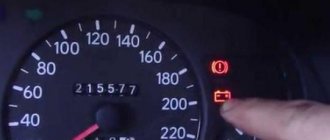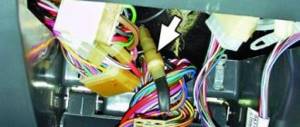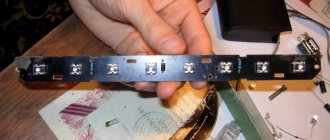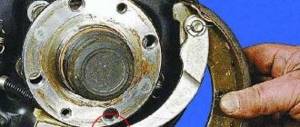Electrical problems
On the VAZ 2109, electrical problems arise over time. An experienced motorist should be able to cope with these problems. It is advisable that he independently eliminate faults on the VAZ 21093i, check the electrical equipment and draw the appropriate conclusions. In this article we will try to help the novice driver and familiarize him with all the basic electrical elements and their malfunctions.
general information
VAZ 2109 electrical faults
Let's start with general information. You should know that the VAZ 2109 has two power sources - the battery and the generator. The battery is designed to supply current when starting the power unit of a car, as well as to power the starter and other 12 V consumers when the engine is not running. When the engine starts, all the “initiative” goes to the generator. Now this element provides current to all consumers, even the ignition system and battery.
When the generator does not provide current
Note. Every driver must know that if the red charging lamp is on on the instrument panel, then no charge is supplied from the generator to the on-board network, that is, the stored battery energy is consumed. It is clear that the supply is limited and depends on the size of the battery and its capacity. Of course, in this case you can drive home without a generator, but you can no longer turn off the car and you will have to drive non-stop.
Work order
So:
- First of all, you need to check whether the alternator belt is in place. It happens that it breaks off.
- If the belt is in place, intact and undamaged, then it is recommended to check its tension. To do this, press with your thumb from above and notice how much the belt is bent. 10-15 mm is the norm.
- We arm ourselves with the appropriate wrench and unscrew the nut securing the generator to the body. Then we insert the pry bar between the generator and the engine cylinder block. Using the lever method, we move the generator and tighten the fastening nut.
Working with a generator
- You need to check whether the corresponding fuse has blown. If yes, then replace it with a new one (more about fuses below).
- We start the power unit and check whether the battery charging lamp goes out. If it goes out, it means everything was done correctly.
- If it does not go out, then you need to check the cable that runs from the generator to the battery (positive). This could be where the problems lie.
Note. There are two wires coming from the battery: the thick one connects the battery to the starter, and the thin one is the one we need.
- We check the integrity of this wire. Maybe it's broken or something.
- You also need to carefully check contacts that may have become oxidized over time.
- All these faults, if found, are corrected. We start the engine and see if charging appears.
- If yes, then have a nice trip!
If there is no charging again, then you need to check the generator itself (see VAZ 2109: malfunctions on the generator and how to eliminate them). To do this, it is better to contact specialists or follow the advice that can be found on our portal.
Advice. As mentioned, you can drive with a damaged generator to a service center or your own garage. In order to minimize the battery current consumption, it is necessary to turn off all devices at this moment, such as the car radio, unnecessary lighting fixtures, fan, air conditioner, heater, etc.
Regulator check
If the motorist is experienced, then he can be advised to check the generator voltage regulator. This component is required to maintain the generator voltage within specified limits, even if the speed and load changes. It is possible that it has “worked out” and the generator is not functioning correctly. By car:
- We arm ourselves with a voltmeter equipped with a scale of up to 15-30 V.
- We always measure the voltage after some operation of the engine at medium speed.
- We measure the voltage with the headlights on, in the place between the corresponding terminal and the generator ground. The norm is thirteen/fourteen V.
- Otherwise, if the value is lower or higher, the regulator will need to be replaced.
Checking the removed regulator:
- We dismantle the regulator.
- Let's check it according to the diagram.
Voltage regulator test circuit
Note. If the regulator on a VAZ 2109 was produced before 1996, then it is better to check it together with the brush holder. This will make it possible to immediately detect broken brush leads and poor contact between the ends of the regulator.
- Turn on the test lamp between the brushes.
- We supply a current of 12 V to terminals B and B and the regulator body.
- Then we will double the current, the voltage is already 15 V.
- If the regulator is faulty, the lamp should not light up at a voltage of 15 V and light up at a voltage of 12 V.
- If it lights up in both cases, then the regulator is faulty and you can even accurately determine that there is a breakdown in it.
- If the lamp does not light in both cases, there is a break in the regulator.
Circuit breakers
VAZ 2109 electrical faults
Fuses are a kind of both defenders and scouts. They are the ones who signal the danger of a short circuit or other electrical problems if they burn out a second time. But electrical problems cannot be put on the back burner, because this threatens to ignite all the electrical wiring and cause a fire.
Note. Remember that it is strictly forbidden to replace a damaged fuse with a new one with a higher rating. Advice. To make troubleshooting easier, it is recommended to use the diagram below.
It is worth noting that different units can be installed on the VAZ 2109: old and new. A distinctive feature of the new fuse box is that it uses new fuses. Instead of cylindrical fuses (as on the old block), blade fuses are used here. In addition, new compact relays are also used in such a unit.
VAZ 2109 electrical wiring faults
Let us now analyze the fuse diagram for the VAZ 2109, since this is very important for working with the car’s electrical system. We will abbreviate the fuses by the letter P if the mounting block is of an old type and by the letter P if it is new. So:
- 1 and 2 P with 8 A (in the old block) and 8/9 P with 7.5 A (in the new block) are responsible for the fog lights.
- P number 3 with 8A and P1 with 10A - are responsible for the wipers, relays and headlight switch valve.
- P4 with 16A and P7 with 30A - are responsible for headlight cleaners, the electric motor of the heater motor, the rear window wiper gear motor, glove compartment lights, heated glass, etc.
- P5 with 8A and P16 with 15A - are responsible for turn signals, hazard warning relays, taillights, coolant temperature and fuel level indicators, etc.
- P6 with 8A and P3 with 10A - taillights, brake lights and interior lighting.
- P6 and P6 s 30A – are responsible for the front electric windows.
- P7 and P10 with 7.5A - are responsible for the license plate light.
- P8 with 16A and P5 with 20A - are responsible for the sound signal and various relays.
- P9 at 8A and P10 at 7.5A - responsible for the left marker and rear left headlight.
VAZ 2109 electrical equipment malfunction
- P10 at 8A and P11 at 7.5A are responsible for the right side marker headlight and the right tail light.
- P11 with 8A and P2 with 10A – are responsible for turn signals and emergency lights.
- P12 from 16A and P4 to 20A - for the rear window heater, cigarette lighter and power socket.
- P13 and P14 with 8A and P15/P14 with 7.5A are responsible for the illuminators/high beams.
- P15/P16 with 8A and P13/P12 with 7.5A - responsible for the illuminators/low beam.
Electrical faults of the VAZ 2109 and their elimination
Instrument panel and its diagram
A common electrical problem on the VAZ 2109 is the instrument cluster. It is built into the dashboard on the driver's side and includes a system of instruments that monitor the current condition of the car. These could be devices such as an oil pressure sensor, an engine speed sensor, or simply a series of warning lights.
VAZ 21093 electrical faults
Let's look at the faults.
Signposts
- If the temperature and fuel level gauge does not work, the cause may be a malfunction of the light bulbs or sensors themselves, or an open circuit in the power supply.
- Treatment: test the entire circuit and check the fuses. If it doesn’t help, then check the functionality of devices and sensors, and then replace them.
Fuel tank arrow
- It also happens that you have just filled up at a gas station, but the indicator arrow returns to the beginning of the scale.
- We check whether the float limiter has been knocked down. It also happens that it is incorrectly installed or adjusted (limiter).
- We remove the sensor and re-adjust.
- If this same arrow constantly jumps and finally drops to the zero mark, the problem is a weak contact of the resistor. There may be another reason: a break in the resistor.
- Treatment: replace the fuel level regulator with a new one.
Light bulbs
- Another popular malfunction associated with the constant burning of this light bulb. The reason may be a short circuit in the sensor itself or its flexible bus.
- Treatment: disassemble the regulator, straighten the busbar and eliminate the short circuit.
Warning lamps
- If the indicator lamps on the instrument panel do not work, then they may have burned out or are loose in their sockets.
- Treatment: lamps are replaced or their contacts are tightened.
- It is possible that the contacts have oxidized. In this case, it is necessary to clean them thoroughly.
Note. In general, in this case it is recommended to test all wiring with a tester.
Problems with the speedometer
- An equally common malfunction that requires the following operation: replacing the cable.
- Before replacing, it is recommended to check the tightness of the tip nuts.
- It also happens that noise is heard when the speedometer operates. In this case, most likely, the flexible shaft was deformed.
VAZ 21093 electrical equipment malfunction
At this point, checking and troubleshooting the VAZ 2109 electrical faults can be considered a completed task. It is extremely important when working with your own hands that you do not ignore the instructions for the car. In addition, it will be useful to study various photo and video materials. If you learn how to fix such problems yourself, you can save a lot of money on your family budget, because the price for services of this kind from auto electricians is excessively high these days.
Recommendations
Comments 12
I had a fire like this on a 9Ki fuel-injected car with a panel without instruments when the car stalled)
Turn off the ignition and check the oil level and brake level. and then after adding it, cut it in. Due to the lack of some half centimeter, my brake squealed. Good luck.
My brake light is on and it’s like some kind of light bulb has burned out.
Well, the lamp has burned out and my light is on, although everything is working... apparently I just need to change the boards in the stops... Regarding the stop: the brake level sensor may be faulty. you can check by simply removing the connector while the engine is running. If it goes out, change it =) the oil pressure level is probably high...if it’s ’94. There doesn’t seem to be a level sensor yet... I could be wrong =) and of course, look at the pads... maybe you have some kind of wear level there)
There is an oil pressure sensor, but there is no pad wear sensor. Here’s what I noticed: when I press the brake, my friend’s brake light comes on and the lamps are faulty, it releases and everything goes out. I also don’t have a monitor for faulty lamps in the block.
Is your oil light on by any chance?
oil light is not on
I don’t know exactly what it is, but I used to have a stop light, I changed the block and the stop stopped burning, but the block is just a new model, my auto electrician told me that the blocks supposedly fit the year of the car, I was told in the store that it doesn’t matter what year and if the auto electrician has hands they grow from where they need to, then it will connect everything fine) I think the block is even an injection one, I can’t say for sure)











